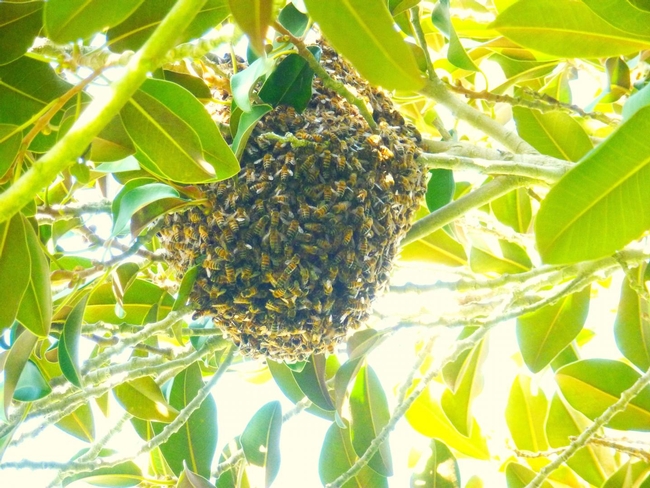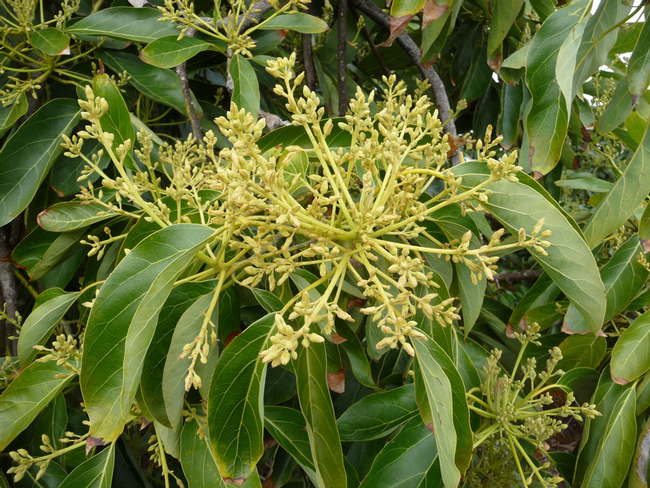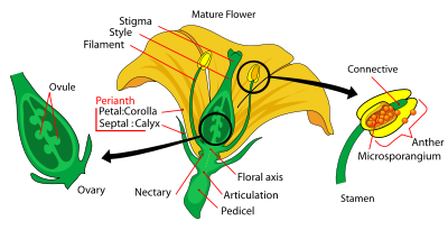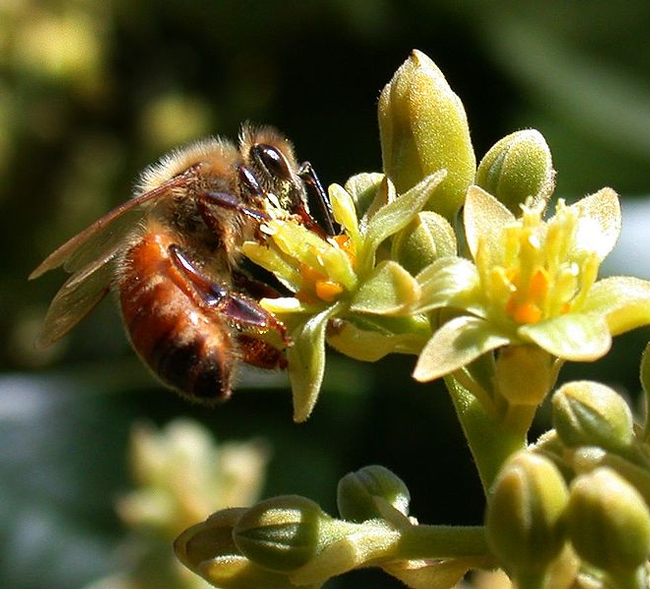Research to help plant growers
protect bees and manage pests.
A group of scientists from the IR-4 Project is doing research to explore the relationships between bees, environmental horticulture plants, and pesticides. This group has put together a database allowing users to create customized plant lists for bees, to research articles, to find pollinator news updates and to research best management practices documents. Check it out:
https://protectingbees.njaes.rutgers.edu/
The research is primarily targeted towards helping environmental horticulture growers, but the information should also produce valuable resources for home gardeners or anyone interested in the interplay between bees, plants, and pesticides.
This website is their hub to:
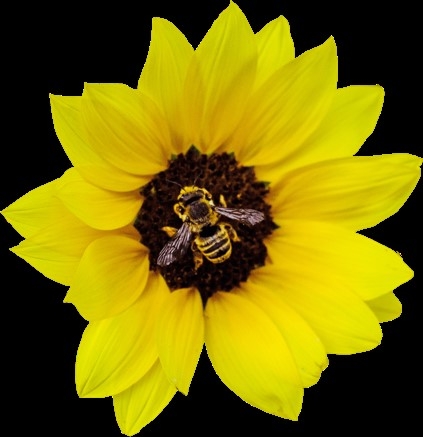
bee on marigold
Posted on
Wednesday, July 10, 2019 at
7:04 AM
Foreign bees monopolize prize resources in
biodiversity hotspot
Immense numbers of introduced honey bees overwhelm native pollinators for access to pollen and nectar
University of California - San Diego
Hike around the natural habitats of San Diego County and it becomes abundantly clear that honey bees, foreign to the area, are everywhere. In a study published last year, researchers at the University of California San Diego found that honey bees are the most widespread and abundant pollinators of wild plants in the world, with the San Diego region having exceptionally high honey bee visitation on native plants--roughly three-quarters of all observed pollinators.
New research from the same team found that honey bees focus their foraging on the most abundantly flowering native plant species, where they often account for more than 90 percent of pollinators observed visiting flowers.
The new study by Keng-Lou James Hung, Jennifer Kingston, Adrienne Lee, David Holway and Joshua Kohn of UC San Diego's Division of Biological Sciences is published on Feb. 20 in Proceedings of the Royal Society B.
"To have a non-native species that removes the lion's share of pollen and nectar in a diverse ecosystem such as ours is stunning" said Kohn, a professor in the Section of Ecology, Behavior and Evolution. "Think about if we had an invasive plant that covered 75 percent of the region's land area--it's similar to that level."
The honey bees' monopoly over the most abundantly blooming plant species may strongly affect the ecology and evolution of species that are foundational to the stability of the region's plant-pollinator interactions, the researchers said.
"It's concerning enough that a non-native species reaches an overall 75 percent numerical dominance--what's more, we now show that their numerical dominance is even higher on the plant species that supply the largest amounts of pollen and nectar," said Hung, a former student of Holway and Kohn who is now a postdoctoral researcher at The Ohio State University. "This finding suggests that honey bees are disproportionately removing resources from the plant species that likely support the greatest diversity and abundance of native pollinator species."
From an ecological perspective, the new assessment could help habitat and wildlife management evaluate pollination services and native pollinator conservation in natural areas where non-native honey bees have become established.
"Our study is a first step in figuring out which plant and pollinator species may be most susceptible to interference from honey bees," said Hung. "This is also a great example of the importance of understanding the natural history of a non-native species when we attempt to evaluate its ecological impacts--both positive and negative."
Native to Europe, the Middle East and Africa, honey bees were introduced to North America in the 1600s. They spread in California after the state's gold rush in the mid-1800s. In San Diego, the great majority of honey bees foraging in natural systems are both feral and Africanized (an aggressive hybrid of the Western honey bee).
Behind the honey bees' ability to preferentially target the most rewarding plant species is the fact that they employ social communication to "spread the word" when flowers with rich pollen and nectar resources are available in abundance. Most pollinating insects native to the area are solitary, and thus not capable of such communication.
"Honey bees are thought to have the most sophisticated communication of all invertebrates. They can communicate the distance and direction of a high quality food source," said Kohn. "Native bumble bees are also social and are thought to communicate that there is a worthwhile floral resource and what it smells like, but they can't communicate distance and direction the way honey bees can."
Native bumble bees made up only 0.2 percent of insect visitors to flowers, perhaps due to competition with honey bees. These findings highlight the importance of considering the honey bee's unique foraging behavior when evaluating its ecological impact on native species.
San Diego County is considered a global biodiversity hotspot where researchers have documented more than 600 species of native bees, numerous other pollinating insect species and more plant species than any other county in the United States. According to the researchers, the high biodiversity, coupled with the fact that many plant and pollinator species in the region are threatened by habitat loss and climate change, means that any ecological impact of honey bees on native species could be especially consequential.
"There is little doubt that honey bees currently play an important role in pollinating native plants here in San Diego," said Hung, "but we need to also consider how honey bees may be impacting native pollinators by competing with them for limited food resources."
The researchers also point out that non-honey bee pollinators are known to increase the pollination success of many crop plants in California and elsewhere, even when honey bee hives are brought to fields by the truckload. So the maintenance of healthy populations of native insects is an important aspect of stable food production.
In addition to possible negative effects of honey bees on native pollinating insects, honey bees may negatively affect native plants as well. Studies in other systems have shown that too many visits by comparatively large and super-abundant pollinators such as honey bees can hinder plant reproduction because of damage caused to flowers. In addition, honey bees are known to visit more flowers on a plant before moving to the next plant than native pollinators. This may increase self-fertilization, which often leads to lower-quality seeds due to the negative effects of inbreeding.
The researchers are now investigating these and other possible ramifications of honey bee dominance in San Diego, although their true impact is difficult to assess since there are no available baseline data from before honey bees were introduced into the area.
"In general, the threats that honey bees may pose to native biodiversity have not been explored very thoroughly, but we are now headed that way," said Kohn, who first became interested in honey bee dominance while hiking in local wilderness areas. "No matter how far away from agriculture or urbanized areas I was, if something was blooming heavily, it was just swarmed with honey bees. I thought it was odd that there were so many honey bees here."
###
The research data was collected in habitats managed by the University of California Natural Reserve System, open space parks in the cities of San Diego and La Mesa and the Otay-Sweetwater Unit of the San Diego National Wildlife Refuge.
Disclaimer: AAAS and EurekAlert! are not responsible for the accuracy of news releases posted to EurekAlert! by contributing institutions or for the use of any information through the EurekAlert system.
https://www.eurekalert.org/pub_releases/2019-02/uoc--fbm021919.php
IMAGE: Non-native honey bees have established robust feral populations in San Diego, such as the pictured swarm. Honey bees currently make up 75 percent of the observed pollinators in San Diego,... view more
Credit: James Hung
https://royalsocietypublishing.org/doi/10.1098/rspb.2018.2901
Posted on
Sunday, March 10, 2019 at
9:01 PM
Over the last 100 million years, native species shaped our ecosystems. Now, farmers bring in non-native honeybee hives by the truckload to pollinate hectares of non-native crops. And the honeybees could be affecting how native bees do their job. In a 2013 study, Lucas A. Garibaldi found that “overall, wild insects pollinated crops more effectively; an increase in wild insect visitation enhanced fruit set by twice as much as an equivalent increase in honeybee visitation.” But native bees face serious competition: Victoria Wojcik, research director for Pollinator Partnership, notes that honeybees could drive out native bees when the two compete for flowers.
The USGS Native Bee Inventory and Monitoring Program designs and develops large and small scale surveys for native bees. As part of that program they also develop identification tools and keys for native bee species. One aspect of creating those tools is creating accurate and detailed pictures of native bees and the plants and insects they interact with. This site is designed to provide easy access to our photographs so that they may be freely used. There is no need to ask permission for any use of these photographs. You can download the original version directly from Flickr at your convenience: https://www.flickr.com/people/usgsbiml/
Volunteers have sent in photos and samples from all over the world. The survey currently has over 4,000 images, offering an up-close-and-personal encounter with our smallest flora and fauna. At this greatly enlarged scale, the bees look otherworldly. Their compound eyes are traced in striking patterns, and orbs of pollen delicately latch on to their surprisingly furry backsides. This small selection of bees from the American West demonstrates an immense, previously unseen diversity and shows viewers there's a lot more to the story of bees than just honeybee hives.
Learn how to collect bees for the survey: http://bio2.elmira.edu/fieldbio/handybeemanual.html
https://www.hcn.org/articles/photos-see-the-wests-overlooked-pollinators-like-never-before?utm_source=wcn1&utm_medium=email
Please contact Sam Droege for further information at sdroege@usgs.gov or or 301-497-5840 or visit their website at: www.pwrc.usgs.gov/nativebees/
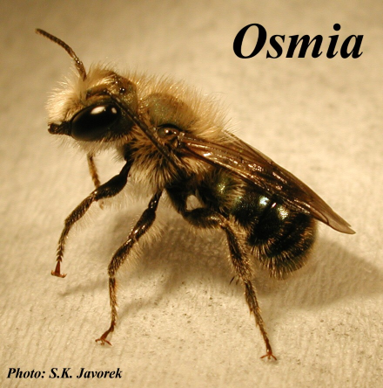
Osmia
Posted on
Monday, February 25, 2019 at
8:45 AM
Where sufficient habitat is available, wild native bee species often provide all of the pollination services needed for high crop yields and fruit quality. Depending on the species, native bees may nest in underground tunnels, hollow plant stems, and tunnels in wood. Bumble bee colonies favor small cavities under lodged grass, in abandoned rodent burrows, in trees, or old bird nests. These unmanaged pollinators are an on-site natural resource, and unlike honey bees, cannot be moved from the field when pesticides are used. In fact, many ground-nesting species, such as squash bees, long-horned bees, mining bees, and sweat bees, construct their nests in the midst of annual and perennial crop fields. To protect these bees, ensure that drifting pesticides never contact adjacent habitat, even when crops or wildflowers are not in bloom. Scout crop fields, and protect ground nests of solitary bees and bumble bees from insecticide spray. Learn more about managing pesticides and protecting bees at:
UC-IPM: http://www2.ipm.ucanr.edu/beeprecaution/
Oregon State University Extension: https://catalog.extension.oregonstate.edu/sites/catalog/files/project/pdf/pnw591.pdf
Xerces Society: www.xerces.org/
Bee Book: http://www.helpabee.org/
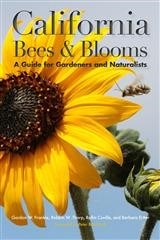
bees and blooms frankie
Posted on
Wednesday, February 14, 2018 at
1:17 PM
Avocado trees can appear completely covered with flowers. A typical full grown healthy avocado tree in California can produce up to a million flowers a year, but, on the average, fewer than 200 flowers per tree will set fruit that will hold and develop to maturity and harvest (about 10,000 lbs/acre, or less). Upon occasion, we have seen some groves with trees setting an average of 500 flowers per tree (25,000 lbs/acre), but this is rare. More commonly, only 100 flowers (or less) per tree will set and hold fruit to maturity (5,000 lbs/acre or less), much to the distress of growers (Bender 2013). Flowering is typically spread over six to eight weeks.
The avocado flower has both functional male and female organs. The male floral organ, which produces pollen, is comprised of the anthers and stamens. The female floral organ is comprised of the stigma (which receives the pollen), style and the ovary. The flowers are small (10 mm diameter). The flowers are usually only open for 2–6 hours, then close and open again for 2–6 hours on the second day. When a flower opens for a second time, it produces pollen and the stigma is not receptive. Flowers then close and remain closed. Flowers will usually be one sex in the morning, closed in the middle of the day and the opposite sex in the afternoon. The timing of the sex phases can be quite defined, but environmental conditions will affect the timing and duration of the male and female phases. The mature tree can produce in excess of a million flowers during the flowering period.
Avocado cultivars are classified in two groups (A or B) based upon their flowering behavior. In the type ‘A' cultivars, the female organs are receptive to pollen in the morning and the pollen is released in the afternoon. Unfortunately, most of the currently available "B" varieties are classed as "greenskins", which return less to growers. In the type B'cultivars, the pollen is released in the morning, while the female organs are receptive in the afternoon. Type A cultivars include: Hass, Gwen, Lamb Hass, Pinkerton, Reed, Gem, and Harvest. Type B cultivars include: Bacon, Ettinger, Fuerte, Sharwill, Sir Prize, Walter Hole, Zutano, Marvel and Nobel. Both type. It is believed that the interplanting of complementary flower types can boost fruit set and therefore yield by making pollen available. The separation in time of the male and female phases has led most observers to believe that a vector or "pollinator" is needed to move pollen from one flower to another.
Steps to take to Improve Pollination (Bender 2014):
1. Bring beehives into the grove. The University of California farm advisors have usually recommended 1 – 2 strong hives per acre, but Ish-Am (2000) suggests that 1 hive is rarely sufficient, and in many cases 4 hives are required. California growers usually have to rent hives (in 2002 hive rentals averaged $42 per hive), but sometimes beekeepers will drop a load of 80 hives for free if the grower has good bee forage nearby. Bees should have water available; floating boards on ponds or reservoirs enables them to land and drink without drowning.
2. Add pollinizers to the grove. Ish-Am recommends a pollinizer tree row be located at least every fourth row. Some growers in California use pollinizers as wind-breaks around the grove, and some replace thinned-out trees with pollinizers.
3. Keep the orchard open. Direct sunlight should reach the lower branches of each tree in order for the trees to produce a “wall” of flowers down the ground. In avocado production, this can only be accomplished by pruning the upper branches on a yearly basis. Keeping open channels through the grove encourages the flight of bees.
4. Other types of bees? Bumblebees have been reported to increase yield in avocados in Israel where honeybee populations were low. New World Carniolan bees have been used in an experiment in San Diego County for pollination: results were inconclusive as to whether they increased yield compared to Italian honeybees, but it was found that they gather more nectar from avocado (Fetscher et al. 2000). Work with these bees, and other wild bees, may eventually reveal a more efficient pollinator for avocado.
Posted on
Monday, July 31, 2017 at
6:37 AM
Tags:
A type (1),
alternate bearing (6),
avocado flowers (1),
B type (1),
bees (23),
honey bees (2),
native bees (13),
native pollinators (4),
nectar (4),
pollen (6),
pollinators (39)



